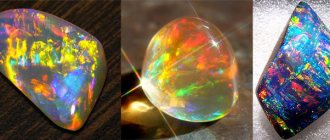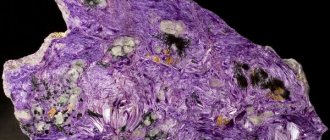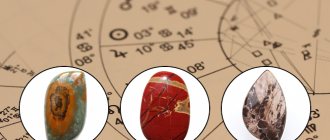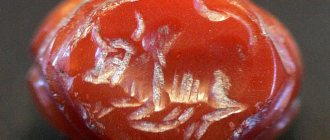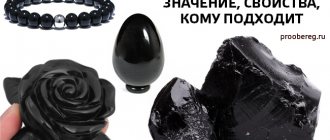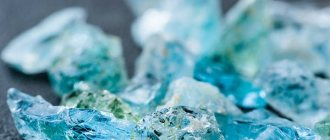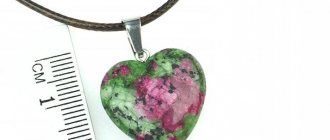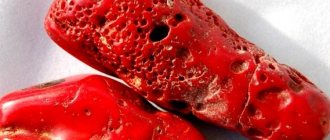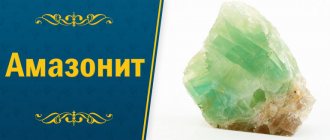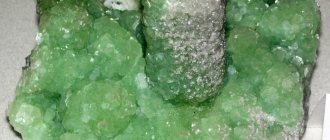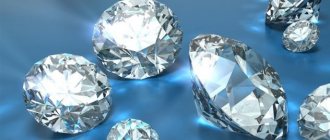Lava is a strong energy stone from a volcano. If we describe it externally, we cannot help but mention the lunar landscape, which is so reminiscent of Lava. The meaning of the stone is unique, as are its natural properties.
Even in ancient times, ancestors attributed the importance of the enormous power and strength of this mineral. According to people, it has magic and healing powers.
On a note! Lava is a stone whose properties have long been studied. This nugget has another name, and it says Basalt. It originated from the African country of Ethiopia. People called the stone this way because of the peculiarities of its origin. The local language of the Ethiopians translated the word "basal" as boiling. And the word lava comes from the French, and from Italian this name means “sliding.”
History and origin
Lava is a stone that is unique in every way; the history of this rock goes back deeper than that of any other nugget. Being the breath of our planet, lava exists exactly as long as the Earth has been erupting magma from its depths for thousands of years.
It was not for nothing that our ancestors attributed immeasurable power, magical and healing powers to lava. The volcano was once considered the point of connection of the four elements - Earth, Fire, Air and Water. Magma, arising in the heart of the planet under the influence of the first two elements, became lava, escaping with a powerful exhalation from the distant depths. With the help of the power of Air, the magma cooled and flowed into the ocean, absorbing the forces of the last of the elements. Today lava is born in the same way as millions of years ago, bringing with it extraordinary possibilities.
This is interesting! Lava stone is also known by another name - basalt. This name for the nugget, based on the peculiarities of its origin, was given by the African country of Ethiopia. Translated from the local language, “basal” means “boiling.” The word “lava” itself came into our language from French, as well as Italian, about three centuries ago, translated as “sliding”, “creeping” or “falling”. This name no longer reflects the formation, but the birth of the stone, its rebirth.
Before it reaches the surface of the earth, lava is considered magma. The temperature of the magma before the eruption reaches 2500˚C, and after it gradually decreases to 500 degrees. When erupting, magma changes properties under the influence of atmospheric gases, turning into lava. If streams of hot mass encounter a body of water on their way, a powerful explosion occurs.
Gas bubbles often leave voids on the surface of the rock. Such porous material turns into pumice. When lava cools slowly, its top layer forms a crust, under which other layers remain liquid longer and continue an invisible internal flow. In the middle of the flow, tunnels are often formed due to the different speed and direction of the flowing mass. Such voids can extend within the flow for a distance of up to 15 km.
It is known that lava from different areas of origin differs in composition. The volcanic material of island arcs (places where oceanic plates are superimposed on one another) is andesitic in composition, while the lava of oceanic ridges is predominantly basaltic in composition.
Scientists have long sought an answer to the question of why some areas produce lava of both compositions, while others are notable only for basalts. The answer was the theory of tectonic movement of lithospheric plates, which states that oceanic crust moves under the island arcs, which, when melted at a certain depth, erupts with andesite lava.
How is it formed
Basalt is given to people by Mother Earth. After all, a mineral is solidified magma that erupted in streams from a prehistoric volcano. And such a terrible action took place millions of years ago. Finding itself on the surface in a molten form, the substance interacted with soil, air, water, and turned into lava. During those long millennia, when the stone lay there and cooled, its structure and properties changed. Such rocks are called lava, igneous or volcanic.
Place of Birth
Lava stone originates and is mined wherever volcanoes rise. The peculiarity of the extraction of this stone is that this process depends on the phase of volcanic activity - if the volcano is active, then the deposits are not developed until the masses are finally formed. When it comes to dormant volcanoes, the lava often lies at a certain depth, forming layers. The age of such rocks often dates back to the Precambrian period.
This is interesting! Sufficient amounts of lava stone are mined all over the world for human needs. However, geologists are convinced that the main percentage of the earth's rock reserves are stored in the Pacific Ocean floor. It has been proven that the basis for the formation of the Hawaiian Islands is basalt rocks. But for now, there is no need to develop the ocean depths.
Places where lava stone is mined:
- Iceland.
- India.
- Greenland.
- North and South America.
- South Africa.
- Ethiopia.
- Australia.
- Tasmania.
- China.
- Italy.
Also read: Anhydrite is a conductor of lunar energy
Any island with a volcanic peak contains an excess supply of lava rock. Russia, as a storehouse of unique stones, is also rich in basalt. Lava is mined in the north of the country (Kamchatka).
Description and uniqueness
The volcano releases various “ingredients” to the surface. When they harden, they become minerals.
Most consist of silicon, carbon compounds, and basalt. The dominant component determines the description: color range, porosity, density, and other physical characteristics of a particular mineral.
The mineral can be white, grayish, tea rose color, bluish, black. But the surface is always uneven, with holes and pores.
Lava stone is recognized as unique: it contains almost all the microelements necessary for living organisms. It is no coincidence that the surroundings of even dormant volcanoes are densely “populated” with all forms of earthly life.
Lava stone
Physical properties
Lava is a porous stone, predominantly black or dark gray in color, with a fine-grained structure. The composition of the breed differs depending on its origin. Each type of stone contains dozens of chemical elements, but iron, aluminum, magnesium, silicon and oxygen have the advantage.
| Property | Description |
| Compound | SiO2 approximately 40 to 95% |
| Lava temperature | from 500 to 1200 °C (up to 2500 °C at the time of pouring and a short period of time after) |
The chemical composition and temperature of formation affect the viscosity and fluidity of lava. The predominance of quartz makes the lava thick, the mass flows slowly, hardens in the form of mounds. The absence of silicon dioxide gives free rein to lava flows - liquid in consistency, such a substance spreads rapidly, forming lava plateaus, covers and lakes. Such a stone is less porous, as it is quickly freed from the gases that saturated it.
Natural pumicite and synthetic analogue
Natural pumicite is an inexpensive mineral; it would seem that there is no point in synthesizing its artificial analogue. However, extraction and transportation costs greatly increase the cost of the final product. It is much cheaper to obtain the stone artificially. Manufacturers prefer the synthetic analogue because it is cheap, does not have foreign impurities, that is, it is more environmentally friendly.
And although it is almost impossible to distinguish a synthetic mineral from a natural one, experts know very well that, due to its structure, artificial pumicite is more durable and lasts longer. Another unpleasant feature of natural stone is that it easily absorbs and retains moisture. Volcanic lava collects sweat from human skin, after which bacteria multiply in the voids of the stone.
Some unscrupulous sellers pass off industrial pumicite as natural, thereby increasing its cost and deceiving the buyer. Most of the products made from volcanic lava, which are positioned as natural, are actually made from artificial pumice. You shouldn’t give up on jewelry with lava, but you need to know the truth about its origin.
Varieties and colors
Different volcanoes erupt volcanic material of different composition, temperature, and color. There are three types of lava based on their composition:
- Basalt. This type is considered the main one. In basalts, 50% of the chemical composition is silicon dioxide, the remaining half consists of oxides of various metals, including iron, aluminum, and magnesium. The flow speed of such a substance reaches 2 m/s, and the temperature is 1300˚C, which causes a multi-kilometer, but small-thick covering of the earth's surface. The color of basalt that has not yet hardened is yellow or red-yellow.
- Silicon. It is a viscous volcanic material with a temperature of about 900˚C. The flow rate is low, only a few meters per day. Viscosity and low fluidity are determined by a higher percentage of silica than in basalts - from 53 to 62. When the part of silicon dioxide reaches 65%, the lava becomes even slower. A special feature of silicon lava is that the material hardens before leaving the crater. The lava solidified inside usually clogs the vent, which leads to a strong explosion during the resumption of the eruption. The color of hot silicon lava is black with a hint of red. Silicon masses quickly solidify without having time to crystallize, forming black volcanic glass.
- Carbonate. This species is notable for the fact that it erupts from the only volcano on our planet - the Tanzanian Oldoinyo Lengai. Half of the composition is occupied by potassium and sodium carbonates. This lava is considered cold and the most fluid, almost like water. The temperature of carbonate volcanic material does not exceed 600˚C. Hot lava of this type is usually dark brown or black. However, after complete cooling, the rock changes color to white, becomes brittle, soft and soluble in water.
Lava is also classified according to its form of solidification. There are:
- Aa-lavu is a stream torn into pieces, solidifying into separate blocks.
- Pillow lava or pillow lava is volcanic material frozen on the ocean floor in pillow-shaped bodies.
- Pahoehoe lava is a Hawaiian name meaning smooth, swollen, or wavy lava.
There is also a difference between basalt lavas according to some criteria, the main ones being color, structure and application. This classification is more industrial than scientific:
- Asian. A dark gray stone used in architecture and also in the production of costume jewelry.
- Basaltina. The ancient Romans knew this variety. Basaltine is considered a more expensive variety, as it is durable and retains its original appearance for a long time. Used in sculpture. Externally it resembles limestone.
- Twilight basalt. The birthplace of this stone is China. The rock is used in construction because it is the strongest among all varieties and has the best resistance to atmospheric factors. The color of the stone is black or dark gray. It is also used in the manufacture of costume jewelry.
- Green Moorish basalt. The nugget contains unusual inclusions that give the stone a rich green color. Thanks to this, this variety looks noble and expensive in jewelry.
Also read: Diabase - a stone of volcanic origin
Each type of stone is used in different fields - esotericism, lithotherapy, industry and jewelry.
Types of Lava Rocks
The process of “melting” rocks in the depths of volcanoes is easy to imagine. Everything boils, hisses and gurgles deep inside the Earth. But there is not enough room for the “cooking porridge”, and this liquid mass breaks out to the surface through the crater of the volcano. Molten magma contains almost all the elements from the periodic table.
Magnesium and potassium, aluminum and titanium, phosphorus and sodium, calcium and aluminum are mixed together. Various chemical compounds are formed. Partially chlorine, fluorine, carbon, hydrogen and other gases evaporate as soon as the mass is released into the air. Magma turns into lava. Hence the name of rocks and stones - lava or volcanic.
This is how we get the familiar ones:
- obsidian;
- pumice;
- pechstein;
- basalt.
This group also includes volcanic tuff, an effusive rock made from ash and compacted stone fragments. It is used in construction as a stone for building walls. The material is easy to process and can be handled with a saw or axe. This is a very valuable quality of tuff, which comes in gray and black, pink and red, yellow and orange, purple and white.
Each of the stones of volcanic origin listed above is not at all similar to its neighbor - neither in appearance and physical properties, nor in area of application.
Igneous rock: andesite
Andesite is an effusive igneous rock, the silica content of which is higher than in basalt and lower than in rhyolite or felsite.
As a rule, it is the percentage of silica in a volcanic rock that determines its color, which is why basalt is dark, and felsite, on the contrary, is light. Although geologists will always chemically analyze a rock before determining its type, in the field, the gray or reddish colored rock is often classified as andesite.
The volcanic stone received its name from the South American mountain range (Andes), where large deposits of this rock were discovered, and where andesite was first mentioned in printed sources. Andesite is less fluid than basalt, and erupts with greater intensity because the gases dissolved in it have a harder time escaping. Andesite is classified as the effusive equivalent of diorite.
Volcanic stone anorthosite
Anorthosite is an unusual plutonic rock composed almost entirely of plagioclase feldspar.
Anorthosite is one of the oldest rocks of the earth's crust. Anorthosites are usually found in areas where ancient igneous rocks are exposed and exposed. Anorthosite is used in industry, as a building material and cladding stone.
Volcanic rock: basalt
Basalt is an effusive volcanic rock that makes up much of the ocean floor.
Black volcanic rock is a fine-grained volcanic rock whose individual grains are barely visible to the naked eye, but basalt also contains minerals such as pyroxene, plagioclase feldspar and olivine, which can be seen in gabbro, a coarse-grained form of intrusive basalt.
Volcanic lava: diorite
Diorite is an igneous rock that is a cross between granite and gabbro. Diorite is mainly composed of plagioclase feldspar and black hornblende.
Unlike granite, diorite contains a very small amount of quartz or alkali feldspar (anorthoclase), and sometimes there is a diorite rock in which these minerals are completely absent.
And unlike gabbro, diorite has a rather light color - half black and half white - when examined under a microscope, it is clear that the diorite contains sodium rather than calcareous plagioclase. If diorite lava erupts from a volcano (that is, if it is of an effusive nature), then, in this case, as it cools, it turns into andesitic rock.
Typically, geologists refer to a wider range of rocks as diorite than its official definition suggests. However, diorite with higher quartz content transforms into tonalite, and increasing anorthoclase concentration leads to the formation of monzonite. With an increase in the content of both minerals, the diorite rock turns into granodiorite.
Dunit
Dunite is a plutonic rock composed of more than 90 percent olivine with a small amount of chromite. The breed got its name in honor of the Doon Mountains located in New Zealand.
The breed comes in light green and dark green colors (sometimes almost black varieties are found) with a massive texture.
Dunite is used to make refractory materials and is also used in foundries.
Black obsidian - Satan's glass nail
If magma cools too quickly, the resulting lava contains rocks and rocks called volcanic glasses. These include the first three names from the list given above.
For obsidian, quartz and feldspar act as rock-forming minerals. In ancient times, knives, axes and other bladed weapons were made from such material. The hardness of the stone according to Mohs is 6 units, density 2.6 g per cubic meter. see. The Mayans and Aztecs at the dawn of our era did not know metal and for a long time made do with products made of volcanic glass.
Now in these areas (Mexico) they make souvenirs from obsidian - they cut out masks, table knives (absolutely flat on one side) or simply sell polished “pebbles” to tourists.
The ancient people of Primorye and Korea (the state of Bohai) used lava stone in religious rites. Volcanic glass was also used in Armenia, where obsidian was called “Satan’s nail.”
The main deposits have been discovered in Iceland, the Caucasus and the Canary Islands, Asia, Siberia and Transcarpathia. Obsidian is used to make dark glass, thermal insulation devices, in medicine (precision scalpels), and to make carved items. Read more in the article “Types and properties of obsidian stone.”
Volcanic stone: felsite
Felsite is the name given to all light-colored stones of volcanic origin. Felsite is a fine-grained rock with a light matte color that may or may not contain phenocrysts (large mineral grains).
It is characterized by a high silica content and belongs to acidic rocks, usually consisting of quartz, plagioclase feldspar and anorthoclase. Felsite is commonly referred to as the effusive equivalent of granite.
A typical representative of felsic rock is rhyolite, which includes phenocrysts and phenocrysts of colored minerals, sanidine and plagioclase. Felsite should not be confused with tuff, a rock composed of compacted volcanic ash, which can also be light in color.
Gabbro
Gabbro is a dark-colored volcanic rock that is a plutonic analogue of basalt.
Unlike granite, gabbro contains no quartz and low silica content, and no alkali feldspar, only plagioclase, usually dark in color with a high calcium content.
Other dark minerals may include hornblende, pyroxene and sometimes biotite, olivine, magnetite, ilmenite and apatite.
Porphyry
The name porphyry is used for igneous rocks with clearly visible mineral grains - phenocrysts - surrounded by a ground mass of fine-grained rock.
Geologists use the term porphyry with a qualifying word to refer to the structure of the underlying rock. For example, andesite porphyry or rhyolite porphyry. As a similar name, such a rock can be called andesite or rhyolite with a porphyry structure.
About the "boiling" stone
Basalt belongs to the main composition of volcanic rocks, which are determined by the silica content in the region of 50%. There are several versions of the name. The Greeks have a consonant word in their language that translates as “main”. The Ethiopians, who spoke Ge'ez (an ancient language), also used a similar combination of sounds in their vocabulary. But translated it means “boiling” or “iron-containing”.
Preference should be given to the second option, since it is believed that the Ethiopians were the first to use basalt volcanic stone. The Roman polymath Pliny the Elder wrote about this in scientific works. Among basalt analogues, we note dolerite (formed at shallow depths) and gabbro (formation depth 3-4 km).
The color of basalt can be yellow, dark gray and black, often with a greenish tint. The structure of the stone is fiberglass. Impurities include olivine, plagioclase and pyroxene. Accordingly, grain inclusions are greenish-yellow, cream and black.
Granite
Granite is composed of quartz (grey), plagioclase feldspar (white) and alkali feldspar (beige), plus dark minerals such as biotite and hornblende.
Granodiorite
Granodiorite is a plutonic rock composed of black biotite, dark gray hornblende, grayish-white plagioclase and translucent gray quartz.
Granodiorite differs from diorite by the presence of quartz, and from granite it is distinguished by the predominance of plagioclase feldspar over alkaline feldspar. Despite the fact that this stone cannot be called a true granite, granodiorite is part of the group of granitic rocks.
Reddish colors indicate the presence of rare pyrite grains, which, when oxidized, release iron molecules. The chaotic arrangement of grains indicates the plutonic nature of the origin of the rock.
Tonalite - a stone of volcanic origin
Tonalite is a common but unusual plutonic rock, a granitoid that does not contain alkali feldspar, also called plagiogranite and trondhjemite.
Granitoids are concentrated around granitic rock, being a mixture of quartz, alkali and plagioclase feldspar in relatively even lobes. As alkali feldspar is removed from true granite, the rock becomes granodiorite and then tonalite. In the composition of tonalite, feldspar is completely absent, which is compensated by the increased concentration of quartz.
Healing abilities
Lava stone is popular among healers as a massage product. Balls made of mineral, when exposed to massage movements, help get rid of blockages in blood vessels, relieve the symptoms of varicose veins and joint diseases. Volcanic rock is also used in the fight against cellulite.
Lava pendant
It is known that lava retains heat for a long time. In contact with the human body, the nugget, together with warmth, transfers the entire range of beneficial properties to the body, thereby strengthening the immune system, relieving tension and stress.
Meditation using basalt is considered beneficial. This helps to reboot the body at all levels, giving the body and mind a break from excessive life activity.
Lava stone stabilizes the emotional background even when carrying a nugget every day. The mineral will give a person lightness, fill him with energy, relieve fatigue, and transfer to the owner all the deep power of the earth. Ancient healers made powder from lava, using it to heal wounds.
Massage with lava stones:
Healing properties of magic stone
The mineral, whose amazing power has been known to more than one generation of people, is valued not only for its magical qualities. It is widely used in folk medicine as a magical remedy for various ailments.
- Stones of blue and black shades are considered powerful cleansers of the body. Our ancestors believed that they remove waste and toxins, acting at the cellular level. This property allows obsidian to be used to treat many ailments, including gout. With this disease, it removes from the body excess salts that accumulate in the joints.
- Obsidian products give a person vitality and also help strengthen the immune system. It is believed that the stone quickly defeats colds. Especially those caused by hypothermia.
- The characteristics of the stone indicate that it has a powerful energetic connection with the kidneys and adrenal glands. Therefore, the mineral is often used to treat diseases of the genitourinary system.
- Wearing such a powerful talisman will help people suffering from diseases of the digestive system. It normalizes the functioning of the gastrointestinal tract and improves digestion.
- Energetically, this stone is connected to the adrenal glands and kidneys. It is recommended to wear it for various problems of the reproductive system. Obsidian is also credited with a unique ability to heal the gastrointestinal tract and improve digestion, calm the nervous system and normalize blood pressure.
- The mineral is able to calm the nervous system and normalize blood pressure in hypotensive and hypertensive patients.
- Obsidian accelerates skin regeneration. It is suitable for use after various injuries and burns.
It is advisable to wear the talisman near the organ that needs help. For example, if a person wants to treat his eyes or respiratory system, he can purchase earrings with obsidian inserts. To treat heart diseases, it is recommended to decorate yourself with beads. Jewelry with this wonderful mineral can be worn not only to get rid of existing ailments. They are also used for preventive purposes.
Surprisingly, obsidian has also been used in traditional medicine. Instruments made from this material are used by certified surgeons during operations.
Benefit for health
Pieces of magma are of great importance for maintaining the health of an individual.
Constantly wearing a talisman helps:
- Improving metabolism in the body. Igneous rock affects the stomach and intestines. Food begins to be quickly digested, unnecessary substances are eliminated from the body.
- Relieving any pain. If you experience pain in your head, muscles or joints, you need to take the talisman in your hands and relax. After a few minutes, the discomfort will disappear.
- Stabilization of the functioning of all body systems. Internal organs receive positive charges from the lava stone and begin to work in accordance with the rhythms of nature.
Important! Basalt, upon contact with the owner’s body, triggers rejuvenation processes. When worn, a person feels a surge of strength, his mental health will be strengthened. Starts to work at full capacity.
Massage balls are created from volcanic mineral. They are very effective in the fight against excess weight and cellulite. Procedures with the following accessories:
- improve blood circulation;
- help to relax severe muscle tension;
- relieve spasms and pain;
- help normalize blood pressure.
From igneous rock, master stone cutters make various utensils for grinding medicinal plants, preparing tinctures and mixtures. Healers claim that drugs that have been in lava tanks acquire additional healing power.
A comforter that gives a light attitude to life - Manganocalcite!
A stone of light pink color, when interacting with which you want to forget all worries and simply surrender to the easy flow of life - such is this glorious representative of the Quartz family. Its magical properties are determined by the Element of Air, which it has absorbed into itself. Calcite without impurities is a transparent mineral with large crystals, otherwise called Iceland Spar. Mangalocalcite has a pink color from mixed manganese. But when hematite or cinnabar is “mixed”, the calcite crystals have a bright red color. A small content of malachite gives a green color, pyrite - blue, azurite - blue (cerulene), and iron - yellow-brown (ferrocalcite). Marble, paper spar, cave formations, calcareous tuff are also varieties of Calcite. In a word, Manganocalcite is a representative of the glorious stone family. But these translucent beautiful Stones are famous for the way they cleanse from fears and grief, relieve worries, fears, nightmares and tensions, and how they immerse their wearer in a stream of love, peace, tranquility. See below for details on using the Stone. For good.
Who is Lava Stone Suitable for?
Lava stone is suitable for different categories of citizens:
- Subjected to unfair actions on the part of officials and government structures.
- Feeling the desire to take a decisive step in life.
- Those who are accused or insulted by others, but people themselves cannot fight back due to indecision.
- Who is looking for support to achieve their goals.
- Graduate students who do not know which educational institution to continue studying at.
- For everyone who wants to find their soul mate.
- Pregnant women who want to protect themselves and their child from evil, envious glances.
- Chronically ill people who are exhausted by persistent illnesses.
- Residents of megacities. Constant stress, fatigue, and nervous overload lead to a thinning of the astral body around a person. He becomes nervous and irritable, and begins to feel unwell. A talisman made of volcanic mineral restores the biofield of its owner.
People who feel that their luck has turned against them should definitely purchase a talisman made from pieces of frozen magma. The volcanic mineral will attract monetary energy, positivity, and useful people into the life of an individual. A person's life will change in the opposite direction.
Lava stone born in the depths of the earth has an unusual appearance. In combination with metals and other gems, the volcanic mineral looks original. Jewelry made from pieces of frozen magma is currently trending. They are worn by men and women of any age. The products go perfectly with any style of outfit. Lava stone not only serves as decoration, but also has strong healing and magical abilities. The energy of basalt envelops a person and protects him from many misfortunes.
Magic properties
It is not surprising that the heart and breath of the planet has strong magic, helping a person at all levels of consciousness and subconscious. Lava is responsible for the root chakra - the basis for the activity of other chakras, connecting human energy with the energy of the Earth. The lava stone itself is energetically both feminine and masculine. Rough lava carries Yang energy, while smooth, flowing lava carries Yin properties.
Lava is considered the oldest home amulet, used by tribes around the world. If you want to protect your home from troubles or uninvited guests, place pieces of lava stone at the entrance to your house or store jewelry made from the mineral as close as possible to the entrance.
Wearing basalt harmonizes a person’s inner world. Thanks to this, the owner of the stone learns to understand himself and his own thoughts, desires, and dreams. Contact with the stone sharpens intuition and teaches you to correctly interpret messages of fate, dreams, and signs. A person feels unity with himself and nature, reveals talents, gains wisdom, which must be directed to the implementation of the most daring plans.
It is also believed that one of its physical properties, fluidity, is transferred to the owner by lava. This allows a person to become flexible, morally flexible, adapt to any current of circumstances, while not losing sight of the intended goals. Thanks to such properties, a person is open to everything new, while the talisman protects against mistakes and wrong actions.
Since ancient times, a lava nugget has been considered a stone of knowledge. If anyone strives to acquire new knowledge, it is necessary to carry a basalt talisman with him. The stone helps to clarify thoughts and reveal mental abilities. It is easier for a person to concentrate on work and achieve perfection in studying the chosen science.
Lava will become a sacred talisman that will definitely bring positive changes. This stone does not like stagnation; calm is alien to it. With the arrival of any person in the life, lava stone will constantly push the owner to move, take decisive action, and achieve goals.
Unusual uses of lava lamps
Don’t be surprised, but even today, the world-famous company Cloudflare actively uses lava lamps in its work.
Moreover, this has nothing to do with lighting. They have a small room in their office with dozens of these lamps that help protect information on the Internet.
Just think, the simplest invention with bubbles from the 20th century protects the digital flows of the 21st. How does it work, you ask?
Video cameras record random swirls and unusual shapes of oil, water and wax in the flasks 24 hours a day. Based on these pictures, the computer generates a cryptographic key.
Such changes cannot be predicted, selected or calculated, the pattern of their transformations, and, accordingly, hacked.
Each person entering the room, changing the beam of light from the window already changes the temperature in the room, which means the waviness and shape of the bubbles.
Areas of application
Lava turned out to be a multifunctional material for humans. Our ancestors identified lava as special stones. During excavations of ancient settlements, archaeologists found not only jewelry, but also tools, masks, and ritual attributes.
The areas of use of the nugget are varied:
- Lithotherapy. Massage balls are made from stone.
- Decor. Aquariums are decorated with lava stone. The mineral not only serves as a beautiful addition - thanks to the presence of lava, the water circulates better, while being filled with all the useful chemical components.
- Grill. Expensive grills use lava rather than charcoal. This stone maintains heat and warmth better.
Also read: Andesite - a durable natural stone
Rock experts have classified basalt as a mixture of basaltic lava and ash that hardens instantly after an eruption. Such basalt has found application in construction, as it has valuable characteristics - strength, noise insulation, thermal conductivity, fire resistance, and durability. Slabs and basalt wool are made from it, the remains are crushed and added to asphalt and concrete.
Volcanic stone is used to lay floors, fireplaces, building facades and tombstones. The only disadvantage of a basalt floor is that over time the stone is polished until it slips icy. In addition, sculptors, furniture makers, and clothing designers use basalt. Jewelers create beautiful silver jewelry with black stones. And although lava products are not so popular today, craftsmen still make beautiful jewelry.
Applications of lava stone
There are several types of basalt, differing in properties and color, which determines the purpose of the mineral. Types of stone:
- An Italian mineral that has an external resemblance to limestone. It is characterized by increased strength, is considered quite expensive and is used to create architectural objects. Its advantage is the preservation of its original color for decades.
- An Asian breed with a dark gray color. It serves as a raw material for making jewelry and is used in decorating buildings.
- Moorish basalt, which has a rich green hue interspersed with various minerals. Looks original and expensive in jewelry.
- Twilight stone is black or dark gray in color. A durable rock that is distinguished by irreplaceable properties in construction: resistance to frost and atmospheric influences. Also used in making jewelry.
Figurines and decorative dishes are made from volcanic stone; it is indispensable as an unusual decoration for an aquarium. However, frozen lava has also found a very unconventional use:
- due to its ability to retain heat, the mineral is placed in the grill to maintain a high temperature;
- used to cover skis, snowboards and other equipment;
- Lava is used to make massage balls to combat excess weight and vascular diseases;
- Basalt insulation is in demand, which is resistant to fire, does not accumulate chemicals and removes condensate;
- stone is used in making ceramics;
- the walls of swimming pools are lined with mineral;
- crumbs unsuitable for other industries are added to concrete or asphalt.
Coarse-grained stone is not used for construction because it quickly erodes. Often, basalt used in industry is not transported, but is used in places where mining is carried out, since transportation increases its cost significantly.
Jewelry with mineral
Lava stone is an affordable material, so products with this mineral are affordable. The average cost of jewelry is:
- Bracelet – 350 rubles.
- Earrings – 500 rubles.
- Beads made from a mixture of stones (pearls, agate, lava) - about 2000 rubles.
Stone beads
Jewelry with lava stone is often complemented with other ornamental minerals, such as tiger's eye, lapis lazuli, agate. There are no fakes, since this material is more than enough, and the cost is already low.
How to distinguish a real stone from a fake, how much does it cost?
A large number of deposits and the low cost of the mineral have reduced the likelihood of running into a fake to a minimum. However, there is still a chance that, in search of an original piece of jewelry, the buyer will purchase an imitation. Natural material will not have symmetrically located bubbles, and it may also contain multi-colored inclusions. A fake may have an unpleasant odor and be overpriced.
The price of basalt jewelry is low - a bracelet made of small beads can be bought for 250–400 rubles. However, when lava is used in a product with other minerals and metals, the cost can increase significantly. Black stone goes well with silver and gold - its color becomes deeper. Basalt also looks good paired with other stones, emphasizing their shade. A bracelet made of beads with a combination of lava stone and jasper will cost 700–800 rubles.
Sources
- https://VelesLife.ru/kamni/vulkanicheskie-mineraly.html
- https://MoyKamen.com/vidy/prochie/vulkanicheskij-kamen.html
- https://PulsKamnya.ru/redkie/lavovye-vulkanicheskie
- https://vseprokamni.ru/vidy/drugie/gornie-porodu-vulkanicheskogo-proishozhdenija.html
- https://zolotoe-runo-sl.ru/dragocennye-kamni/lava-kamen-svojstva.html
- https://orif64.ru/oberegi/kamni-vulkanicheskogo-proishozhdeniya.html
- https://zakamnem.ru/vidy/vulkanicheskij-kamen
- https://alloberegi.ru/kamni/vulkanicheskie/
Astrological compatibility
(“+++” – the stone fits perfectly, “+” – can be worn, “-” – is strictly contraindicated):
| Zodiac sign | Compatibility |
| Aries | +++ |
| Taurus | + |
| Twins | +++ |
| Cancer | + |
| a lion | +++ |
| Virgo | + |
| Scales | +++ |
| Scorpion | +++ |
| Sagittarius | + |
| Capricorn | +++ |
| Aquarius | + |
| Fish | + |
Astrologers are unanimous in their opinion that the creation of a volcano suits all signs of the Zodiac, without exception. But like other minerals, lava stone has an attachment to certain constellations - these are Leo, Libra, Capricorn, Aries, Scorpio, and Gemini. People born under these signs will feel lucky in the implementation of plans, and will also be able to quickly assimilate the experience gained, thereby gaining life wisdom in the shortest possible time.
Is this stone right for you?
Benefit for health
The healing properties of lava stone make it a powerful tool for improving well-being and improving the functioning of the body’s internal systems. Here are the problems it helps solve:
- Normalizes intestinal motility and accelerates the process of digesting food, preventing it from stagnating in the digestive tract. Thus, the maximum of useful substances remains in the body, and everything unnecessary quickly leaves it.
- Strengthens the immune system. Lava stone contains a huge amount of useful substances that destroy viruses and bacteria, preventing them from entering the body.
- Relieves muscle, joint and headache pain. At the formation stage, the stone received a powerful magnetic charge from the earth’s core, which has a positive effect on pain areas.
- Normalizes the functioning of the cardiovascular system. Thanks to the magnetic impulse, it brings its rhythm into line with natural rhythms.
- Cleanses the body of toxins. This is accomplished through electrification, which occurs when the stone comes into contact with the hair on the human body.
- Saturates the body with vitamin D. This occurs due to the fact that the black color of the stone attracts the color of the sun.
Interesting Facts
One night in 1977, Mount Nyiragongo erupted on South African territory. The explosion was so powerful that the walls of the crater split. The lava of this volcano was very liquid; this rapid flow rushed at a speed of 17 meters per second. Several nearby villages with sleeping inhabitants had no chance of escape that night.
In addition to the high temperature and high flow rate of the hot substance, during a volcanic eruption, clouds of ash, cameos and poisonous gases are thrown onto the surface. Such a volcanic mixture once wiped out the majestic cities of the Romans - Herculaneum and Pompeii - from the face of the earth.
In Iceland, there is a known case where lava flows under the frozen upper crust continued to move invisible, remaining hot for several centuries.
5/5 — (1 vote)
When overheating occurs
In this process, the most important thing is not to overheat the liquid, otherwise the wax lumps will simply crumble into small balls and the effect will not be the same. If this happens, immediately turn off the lamp for at least 40 minutes.
If small balls constantly appear, try changing the light bulb to a lower power. Some models come with a dimmer built into the cord.
By adjusting the backlight, you can thereby change the power of the light source without replacing the light bulb itself.
The lamp can operate continuously for no more than 8-10 hours. After this, the lamp should cool down.
Without a timer, how can you understand that the shutdown time has come? Usually, after prolonged work for 7 hours in the flask, the so-called “big ball” phase begins.
This is when, instead of several balls of wax, one large one is formed, which hangs at the bottom of the product.
If you see such a picture, turn off the lamp before it completely overheats and flies into the air.
Why basalt jewelry is attractive for men
Basalt jewelry for representatives of the stronger half of humanity is characterized by their characteristic “masculine” features, embodied in a combination of semi-precious stones, leather and lava. This whole cacophony looks something like this: - leather is taken as the basis, - in some way fossilized lava is added to it in the form of beads, rings or flat pieces inlaid with gems. Each separately created ensemble necessarily means something. But basically, men's jewelry made of basalt is a symbol of self-confidence and strength, balance, calmness, control over current situations.
The meaning of basalt jewelry for women
Due to the fact that female representatives are much more expressive and emotional than men, they tend to believe in all sorts of magical things and seek benefit from beautiful things in everything. Especially if they are made of volcanic stone. Modern fashionistas wear them for the reason that such accessories not only dilute the image with bright accents, but on an energetic level fill the body with the power of energy and improve the activity of mental abilities. The last criterion is perceived especially acutely by emancipated individuals. That is why the demand for basalt products is high. Many people don’t even chase ready-made crafts so much as they just want to buy lava beads in order to independently create their own personal talisman in the form of a bracelet or necklace that can protect them at crucial moments, helping them master new knowledge on the path to career heights.
A product gifted by the Earth itself
Basalt is the same stone that has been revered by people from time immemorial. It has long been considered a gift from the Gods, appearing from the deep depths. And for the ancient Chinese, volcanoes were generally the basis of the foundations, since, in their opinion, they combine the most powerful natural forces. Accordingly, the stone obtained from the heart of the planet was automatically endowed with healing properties. Which, in principle, is not unreasonable. Even then, a long time ago, basalt was credited with properties that helped restore vital energy and protect against “bad evil.” Over time, this version only became stronger, gaining support in the form of additional capabilities - to warm, to tone, to calm. And science adheres to this version, confirming the positive effects. The mineral is filled with trace elements that have a beneficial effect on all living things around - in places where lava accumulates, there is maximum strength and diversity in both flora and fauna.
Useful tips
There are some secrets that will help significantly enhance the positive impact of lava stone on its owner. Please pay attention to these recommendations:
- It is important to ensure contact of the stone with the skin. Place the talisman on your bare hand. During the cold season, hide it under your clothes.
- To make a powerful talisman bracelet, string beads onto red wool thread. The fiery color symbolizes volcanic lava, the energy of which is responsible for success in your career and personal life.
- Wear the talisman with the stone constantly, without taking long breaks. This contributes to the accumulation of positive energy.
- Do not remove the stone during water treatments. He is not afraid of water. On the contrary, it is cleansed of negative energy accumulated from outside.
